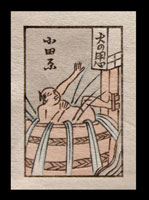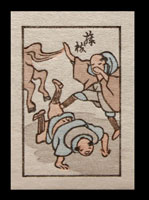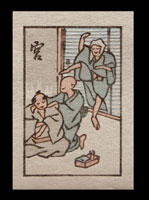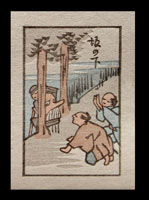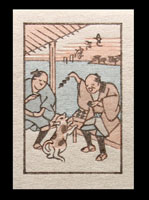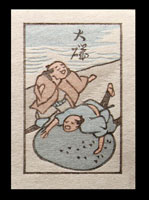'Embrace the Delight'
Additional information on the 'Hizakurige' group of prints
Background
This is the note included with the prints: Here we are with the final 'reproduction' group in this year's series (next month it will be the final group of designs from Jed-san). The prints you see here are just a portion of the original set, which contained 55 prints in all. That should be enough of a hint to tell you what the theme is - it could be nothing else but the famous '53 Stations of the Tokaido'. (The discrepancy in the numbering is because traditionally, the start and finish stages were not counted ...)
The prints here are of course not from the most famous of all Tokaido sets - the one designed by Hiroshige in the 1830s - but from a matchlabel set published in the early Showa period (just pre-war), depicting the adventures of Kita and Yaji, a pair of characters who made their way down the highway in the comic novel 'Hizakurige', written by Jippensha Ikku and published in 1802, long before Hiroshige's prints. I have no space here in this note to tell you about what our two heroes are up to in each print, so I will create a page on our website with supplementary information. Be warned though ... great literature this isn't, as you can perhaps guess from the scenes depicted here!
Supplementary Information
One 'quirk' with the Hizakurige is that the original book was not actually a 'Tokaido' journey; the two main characters were on a pilgrimage to the shrines at Ise, which meant that they only followed the Tokaido as far as Yokkaichi, and then turned off and headed south. When it came time for the Showa-era group to create their Hizakurige set of prints, they wanted to do it as a classic Tokaido journey, so they adapted the original and did a kind of mix-n-match, taking episodes from some of the later published 'sequels', and using them in this set.
Arai: Yaji and Kita are on the ferryboat between Maisaka and Arai. Some of the passengers are dozing, others are silently watching the scenery. An old countryman, dressed in an old garment, seems to have lost something, as he is continually looking under passengers' knees, or lifting up the matting on which they are sitting.
They repeatedly ask him what he has lost, but he won't tell. Not his pipe; not money; 'nothing, really ... It's all right.'
Pressed further, he finally admits. 'Well ... it's my snake ...' Pandemonium.
A minute later, it is finally found, and the old man tucks it back into his clothing ...
(from Satchell): Kita jumped up and caught hold of the old man's coat. But just then the snake put its head out, and Kita gave a yell and jumped back. Yaji then tried to hit the old man with his long pipe. This made the old man angry, and he caught hold of Yaji and commenced to struggle with him, while all the other people in the boat tried to separate them. Then the snake put its head out of the old man's bosom and began twisting round and round.
'There it is,' they all cried. 'Kill it, kill it.'
Kita pulled out his dirk and gave the snake a blow on the head. Upon this the snake twined round the dirk, and when Kita tried to throw it into the sea the dirk slipped from his hand and both the snake and the dirk went overboard and disappeared in the water. The loss of his dirk disconcerted Kita, but all the people cried, 'We've got rid of the snake, at any rate, though it's a pity about the dirk.'
Odawara: The bath at the inn where Yaji and Kita were staying was a type known as a goemon-buro (Goemon-style bath), which has wooden sides, but a metal bottom, underneath which is the fire to provide heat. The metal becomes too hot to touch, so a wide piece of wood - shaped to fit just inside the circumference of the bath - is used. When you approach the bath, this is floating on the surface; as you get in, you push it down to the bottom with your feet, thus protecting yourself from the hot metal.
Yaji and Kita were not familiar with this type of bath, so - thinking that the wood was simply a lid - put it aside and - in turn - plunged in, burning their feet in the process. To try and obviate this, they grasped at the idea of using a pair of wooden clogs to protect their feet. Yaji managed to have his bath this way without much incident, but when it was Kita's turn, he was enjoying himself so much that he began to sing and dance about in the water.
(from Satchell): "... Kita, what with continually jumping up and down when he found a certain portion of his body was getting too hot, and clattering about on the clogs inside the bath, broke the bottom out and sat down violently on the oven beneath, while the water running out of the bath turned into scalding steam ..."
Fujieda (from the Satchell translation): ... they paid for the food and started off, and soon reached Fujieda, where, at the entrance to the town they met an old man with a bundle on his back who was riding on a very restive horse. Just as he was passing, the horse came into collision with Kita, sending him sprawling into a puddle. This made Kita very angry, and he jumped up and seized hold of the old man.
'Here, old chap, haven't you got any eyes?' he cried. 'Can't you see where you're going? You'd better take something for it.'
'Dear me!' said the old man. 'I'm very sorry'.
'Very sorry? I should say you were. But that won't do. You may think you've got hold of something easy, but I tell you I've got a glare like a gold dolphin if I'm put to it. I'm the sort of man who's bathed in cold water ever since he was born.'
'Well, if you're used to bathing in cold water it's all right,' said the old man. 'But I'm afraid that wasn't water you fell into; it was horse piss ...'
Miya: another long and rather contrived story. A masseur (blind) is in their room at the inn, and they have a bit of 'fun' at his expense while he is working on them. Kita pretends to dance to some shamisen music coming through from the next room, encouraging the masseur - who is working on Yaji - to applaud his (non-existent) performance.
But the masseur has his revenge a bit later, when Yaji has gone out to the bath, and it is Kita's turn for a massage. The masseur begins to sing, but at certain points he blocks Kita's ears, and sings insulting phrases. Kita, totally unconscious of being the butt of the joke, then joins in the choruses ... Yaji has returned from the bath, and enjoys the sight of his friend being made fun of ...
Sakanoshita: (probably) from Kompira in one of the sequels ... We're still researching, trying to find the story here ...
Okitsu: a rather weak episode (perhaps something lost in translation ...). Yaji and Kita have purchased some sweets from an old lady running a run-down teahouse. They are not tasty.
After much banter back and forth with the woman, they try to give the remaining sweets to a young boy, but he is not interested, 'I don't like sweets covered with bran ...'
They end up offering them to a dog, who is completely appreciative ...
Oiso: the story behind this one is a bit long and contrived ... Tora no Ike (Tiger Pond) was apparently the name of a small body of water in this area. A Benten Shrine was associated with it, and a childless woman is said to have prayed to the goddess. After placing a small stone from the shrine beneath her pillow, she was able to conceive, and the daughter was named Tora, after the pond. As the girl grew up, her own growth was magically accompanied by that of the stone, which became larger and larger over the years.
The woman Tora eventually became the lover of Soga no Juro, one of the Soga Brothers of legend. Upon her death, she (the stories are vague on this next point) became the stone, which now went by the name Tora-ko Ishi (Tiger Cub Stone). Legend attached says that it retains feminine attributes, and will only allow itself to be picked up by a handsome man ...
Kita - of course - tries to lift the stone ... and - of course - fails ...

